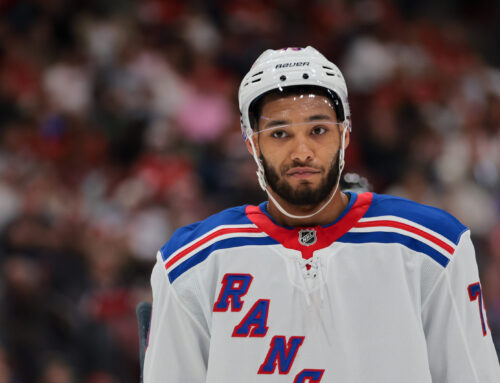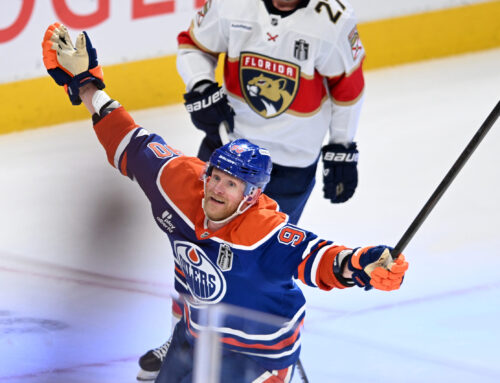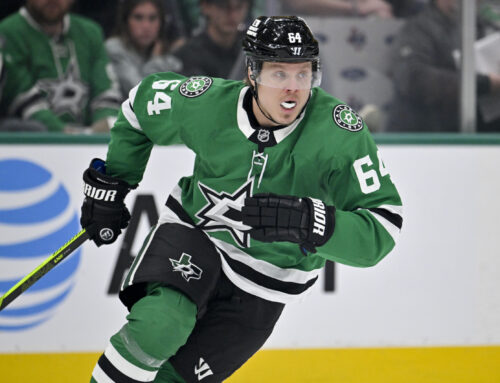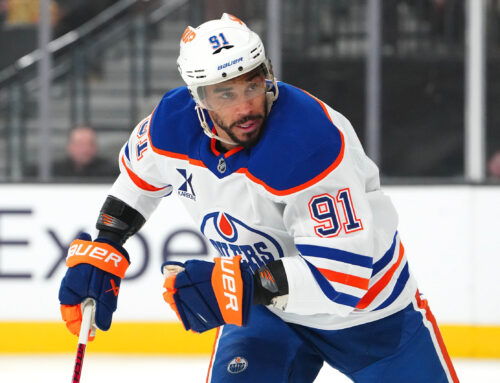If there was ever a season where you wanted to go the zero-goalie rule (waiting until late in the draft to select a netminder), this would have been the year.
Scoring was up to an average of 3.18 goals per game per team, the most since 1993-94. The uptick in scoring led to plenty of surprising players, so much so they have to be split into two columns. A couple of weeks ago, we focused on the top 10 surprising defensemen. This week, we’re going to look at the forwards.
Keep in mind, we’re looking at production that came as complete surprises, players who outscored their projections by at least 20 points, if not more. For example, Connor McDavid‘s season was great, but two years ago, people were surmising he would one day hit 150 points after he hit that pace during the 56-game covid season.
Jack Hughes is another example who won’t be listed. Last August, in a column about the top 10 players ranked too low on Yahoo, I wrote: “In eight months from now, Hughes will be that player that we all wondered why we didn’t take him in the top two rounds … If he can stay healthy, he’s a threat for 100 points… He’s poised to become an elite player.” So I can’t consider his 99 points in 78 games as a surprise.
Below are 10 forward who surprised us all this season.
10. Tommy Novak
Novak won’t be recognized on many surprising lists. After all, his 43 points (tied for 164th) don’t stand out. However, the 25-year-old spent the first few months of the season in the AHL, where he had 26 points in 25 games. He was called up just before Christmas and had an immediate impact with eight points in his first 10 games. Starting on February 18 to the end of the season, he was magnificent, as he had 32 points in 30 games. That forced the team to give him almost 17 minutes per night (before that, he was averaging 11:25). Those 43 points in 51 games overall puts him on an 82-game pace of 69 points. That’s a huge improvement over his rookie season of last year when he had seven points in 27 games, a 21-point pace. He was eventually given a spot on the top power-play unit, which led to 12 man-advantage points. He’s not as sexy a pick as some others on this list, but anyone who picked him up off the waiver wire for the last half of the season was thoroughly surprised.
9. Brock Nelson
Truth be told, despite being in the league since 2013-14 and generally having a healthy career, Nelson wasn’t sought after in points-only leagues unless those leagues were pretty deep. He had only cracked the 50-point barrier in three of his first nine seasons, and his high was 59. This year he reached 75 points, which came from nowhere but doesn’t seem to have any great reasoning behind it. His 2.7 shots per game are slightly higher than his previous high of 2.6. His shooting percentage of 16.2 per cent is close to his career average and actually down 5.4 percentage points from last season. His power-play production is only three points higher than his previous best. His ice time is pretty much on par with previous seasons. He wasn’t playing on the top line or with elite linemates. It was just a year when everything went perfectly and he finished with 16 more points than his previous best.
Not every surprising player needs to be putting up 90-plus points. Oftentimes, some of the more surprising players are those who struggled their first few years in the league, only for that player to rise from the ashes to become fantasy relevant. That’s what we have with Mittelstadt. His first four seasons in the league were awful for fantasy hockey and saw him deal with injuries, healthy scratches, a demotion to the AHL for half a campaign, and less than 13:30 per night in each of his first two years. This season, he managed to break through into fantasy relevance, finishing with 59 points in 82 games, buoyed by his 17 points in his final 11 games when he was moved to the top line to replace the injured Tage Thompson. His 16 power-play points were a nice surprise as well. Some of his overall numbers aren’t that great (his minus-eight can be forgiven, but his 1.6 shots per game can’t), however, there’s no doubt his point total was unexpected.
7. Zach Hyman
In the preseason, I used Hyman as an example of a player who isn’t guaranteed to hit the 70-point mark just because they play with elite players. After all, he played with Auston Matthews/Mitch Marner in Toronto, and Connor McDavid/Leon Draisaitl in his first season with the Oilers, but topped out at 54 points. This year, that changed as the Oilers put up 3.96 goals per game, almost half a goal per game more than the previous season, and the second-highest per-game total for any team since 1996-97. The only better team was last year’s Florida Panthers, who had five or six surprising players as well. Hyman finished with 83 points in 79 games. He increased his shot rate from 2.8 a year ago to 3.5 this season, which, to go along with his shooting percentage of 13 per cent (about average for him), led to a career high of 36 goals. He was also given more time with the top power-play unit, which led to 26 power-play points, smashing his previous high of 10.
I flip-flopped on this spot quite a bit. I’d entertain a debate that Kuzmenko and his 73 points might deserve it more as many of us have been burned by hyped KHL players debuting in the NHL some KHL success (Sergei Plotnikov, Roman Cervenka, Evgeny Medvedev and Vadim Shipachyov to name a few), but there have also been some successes. Since he had never played in the NHL before, we don't have a baseline to determine how surprising he was. However, Pettersson’s season was simply magical. In his first four seasons, he had three years where he had 66 or 68 points, and another injury-plagued campaign where he finished with 21 points in 26 games. This season, he finished with 102 points. He upped his shot rate from 2.4 shots per game to 3.2 while continuing to have a high shooting percentage (this year’s 15.5 per cent is the lowest of his career). His ice time was up almost two minutes per game and he was seeing career highs while killing penalties, tied with teammate J.T. Miller for the league lead with nine shorthanded points.
5. Tim Stutzle
Most of the preseason projections had Stutzle taking the next step and finishing with about 70 points. NHL.com had Stutzle finishing with 69 points. The Hockey Writers predicted he would finish with about 70 points. The Hockey News Pool Guide had him at 76 points. Dobber’s preseason guide had him at 63 points but had his upside pegged at 97 points. Well, Stutzle managed to outperform almost all projections, finishing with 90 points, 32 more than the previous year and leading the Sens in goals, assists and points. Stutzle finished with 21:16 of ice time, almost three minutes a night more than a season ago.
4. Jeff Skinner
Skinner is another one of those veteran players who not only managed to reach 70 points for the first time, but he reached it pretty handily. His previous career high was 63 points, a mark he reached on four different occasions, including in 2021-22. However, after each previous time he reached that mark, he saw a decrease in production of at least 14 points the following campaign. He had a history of not being able to build on career years, so you would have been forgiven for shying away from him in preseason drafts this year. There was no reason to worry as he finished with 82 points while continuing to play on the top line with Alex Tuch and Tage Thompson. He also had a career-high 21 power-play points.
3. Jamie Benn
Eight years ago, Benn won the Art Ross trophy with 89 points. He had a couple more productive seasons after that, and then he dropped like a stone in water. In the last four years preceding this one, his point production ranged from 35 to 53. Even if you look at his 82-game pace to account for the Covid-shortened season, his point pace ranged from 46 to 56 points. A year ago, he finished with 46 points in 82 games. No one had him pegged for a comeback. So of course, he finished with 78 points, an increase of 32 points from a year ago and only 11 off his Art Ross trophy season, even though he averaged only 15:47 per night, his lowest since 2009-10 and about a minute less per night than a year ago. Two of his biggest reasons for his great season? His power-play production was at 30 points, matching his career high and a 19-point improvement from last year. As well, his shooting percentage skyrocketed to 17.4 per cent, almost double his 9.9 per cent from a year ago and easily the highest of his career.
It didn’t take long for Robertson to turn into a star, and it took an even shorter time for Robertson to become fantasy elite. His rookie season in 2020-21 saw him put up 45 points in 51 games and finish as a runner-up for the Calder trophy to Kirill Kaprizov. He became a point-per-game player in his second season, finishing with 79 points in 74 games. Many figured he would flirt with 80 points again, but he demolished those projections and finished with 109 points, tied with Matthew Tkachuk for most points by a left winger this season. His 46 goals led all LWers. The 109 points are the second-most in Stars’ history, trailing Bobby Smith’s 114 points that he had in 1981-82, back when NHL teams scored 4.01 goals per game, highest in modern NHL history. Robertson’s 41 power-play points are also second in team history, trailing Smith’s 44 back in 1980-81. Robertson also finished with 3.3 shots per game and a plus-41.
It will be interesting to see if RNH is a one-year wonder (similar to Chris Kreider and Nazem Kadri a year ago), in the sense that he’s an older player that obliterated his previous career highs in goals, assists, points, power-play goals and power-play points. His ice time and power-play time were in line with previous years, and he still spent a good chunk of the season on the third line. But he finished with 104 points, 35 higher than his previous high of 69. There are a few reasons for a 35-point increase. One is his health. In eight of his first 11 seasons, he played 65 games or fewer. This year he played all 82 games. He also never let up on his torrid start. Usually, he starts hot and then cools off; this year, he continued to stay hot all season, and never had a single three-game pointless streak. Finally, his power-play production was obscene. He finished with 53 power-play points, double his previous career high of 26.





 SEA
SEA CHI
CHI OTT
OTT EDM
EDM DAL
DAL STL
STL ANA
ANA FLA
FLA CBJ
CBJ L.A
L.A
